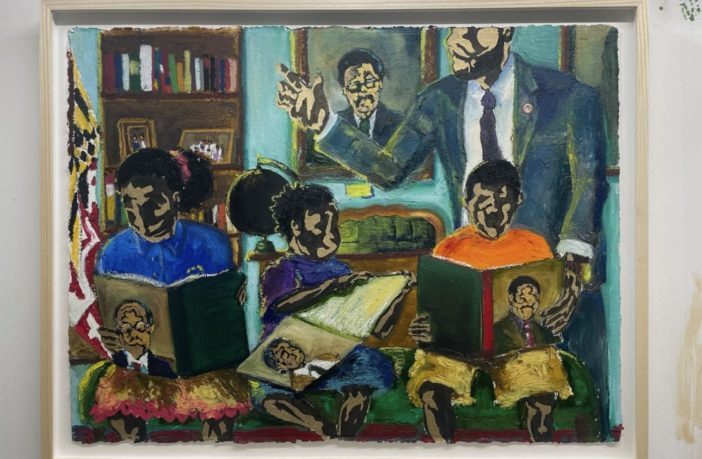By Aria Brent,
AFRO Staff
Earlier this year Gov. Wes Moore made history by becoming the first Black man to be the governor of the state of Maryland. Moore is now a part of the rich, Black history in the state that is being preserved and told by local artists like Will Watson.
Watson is a visual artist and native of Indianapolis, Ind. However, he’s been in Charm City for about seven years. The art that he’s creating is telling decades worth of Baltimore history.
Watson’s painting “For Posterity” portrays St. Sen. Cory McCray speaking in a Baltimore City Public School about the first four Black state senators in East Baltimore. Former senators Robert Dalton, Robert Douglass, Nathan Irby and Nathaniel McFadden are depicted in the portrait and are being read about by the children in the painting.
“What really inspired the piece was his work in the Baltimore City Public School system. He would often go to a former school that I worked at –Montebello Elementary/Middle School, and he would do a lot of work there with those kids and those students,” said Watson, when discussing St. Sen. Cory McCray’s involvement and inspiration for the piece.
“That was really near and dear to my heart and my subject matter right now is pretty much dealing with youth empowerment and just thinking about the kids and the future.”
McCray shared with the AFRO that he chose Watson to commission the piece after several people recommended him. The two have similar values and consider themselves responsible for telling Maryland’s Black history, so working together came very natural for them.
“We vibed really well, and we’re of the same generation so we had the same outlook on stuff. Being in the position that I’m in, I feel it’s necessary to honor these people,” said McCray.
Watson prides himself on his artistic style, which he describes as an “amalgam of gestural-abstraction and representational figuration.” He noted that showing Black people from this lens provides an opportunity to dream beyond what’s normal and typical as far as representation goes. All the while allowing them to still grasp something symbolic that becomes essential to human beings.
Despite him drawing inspiration from McCray, he was given full creative freedom for this commissioned piece. Watson took advantage of this by keeping his creativity open and setting the goal of creating a timeless painting, where the historical figures never have to worry about their legacies fading because they have infinite life in the piece.
With the belief that Black art is needed more now than ever to tell Black history and to continue to give our narratives infinite life, he encourages artists to use art as a tool for teaching.
“Black art right now, it has the power of being a door opener for knowledge and history and inquiry,” said Watson, when explaining how crucial Black art is in our current society.
“Now with all of these kinds of weird laws and everybody trying to take the educational component of African-American history out of schools I think it’s important for artists to continue to think about finding new ways of being didactic. Finding newer ways to continue to educate through visual images,” he continued.
Along with recognizing the need for Black art nowadays, he also realizes that many artists are doubling as content creators and entertainers as a way of reaching their target audiences.
He said, “It plays an important role right now because artists are content creators, they’re entertainers. The whole visual side of this thing is what’s really important and I think it’s not to be taken lightly, the information that’s being created and put out. I think it’s a big role for African American artists to open up the playing field.”
To check out more of Watson’s art, you can follow him on Instagram at: Will_Watsonart



